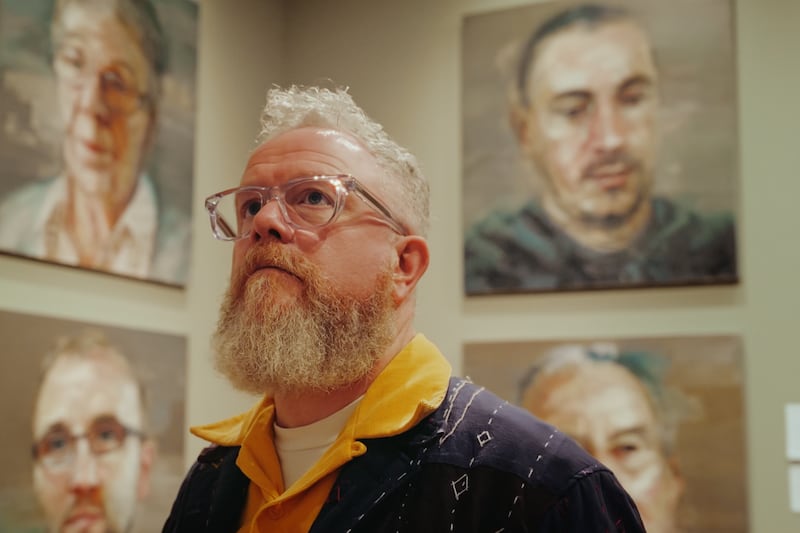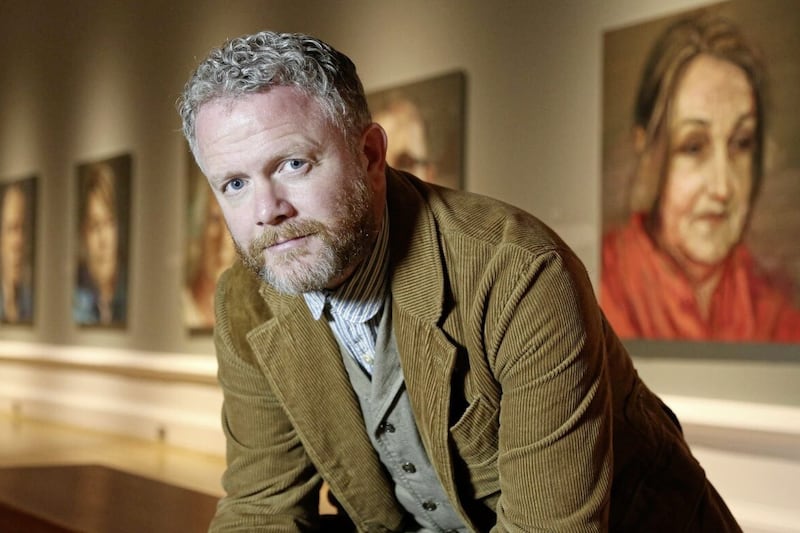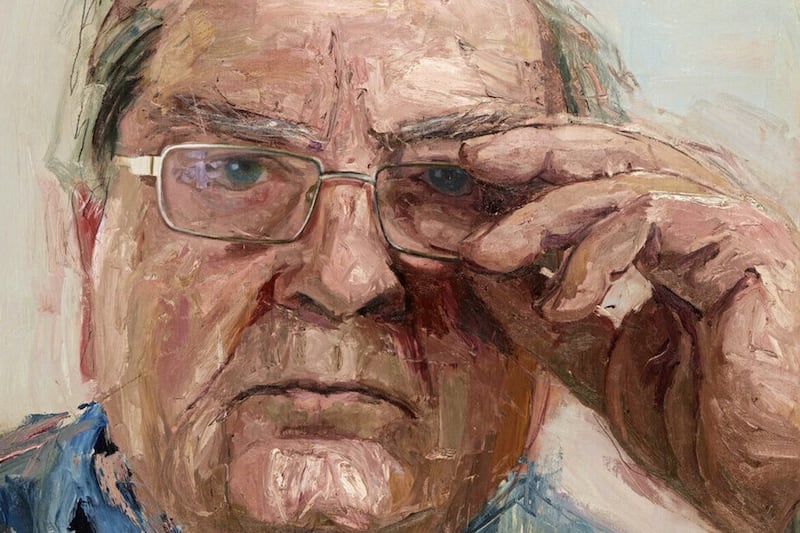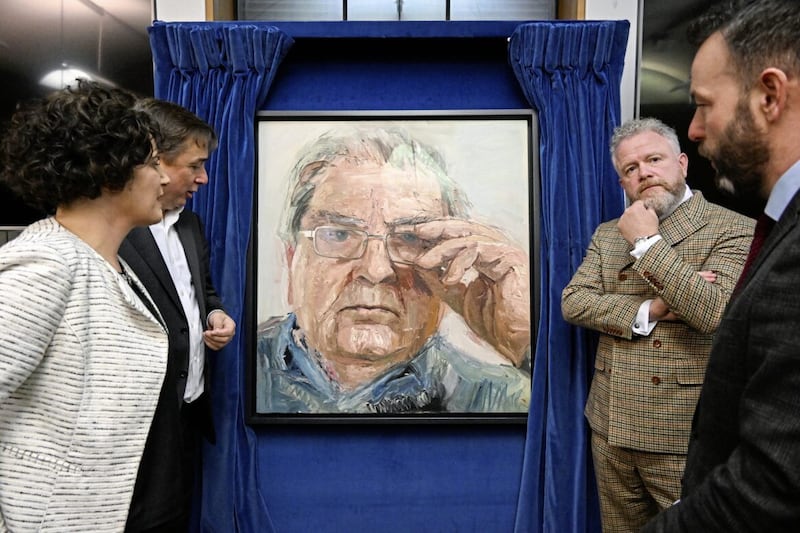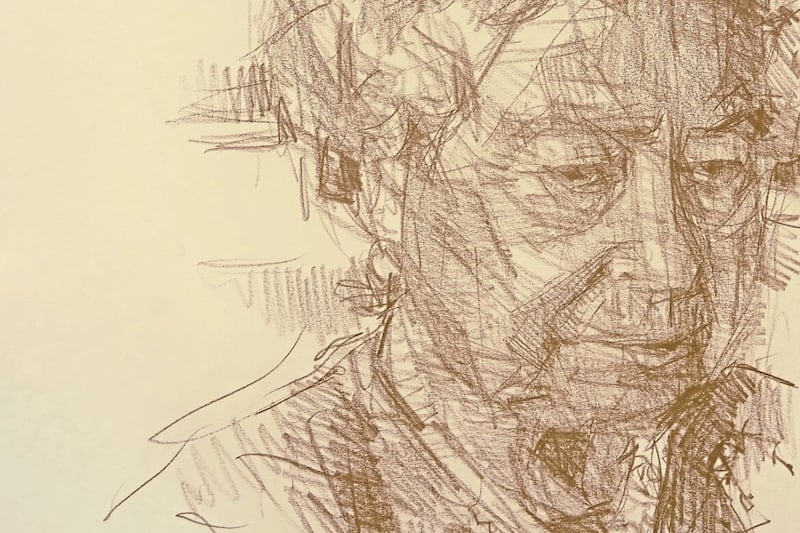BELFAST artist Colin Davidson is about to lock up his studio for the day when he catches a glimpse of himself in a mirror and has an unscheduled stand-still moment of recognition – the type of ‘revealing of the soul’ moment, in fact, that he might aim to capture in one of his many portraits.
The multi-award-winning painter, known for his large-scale canvases of famous faces from across Ireland and beyond, is turning his penetrating eye back on himself; partly as a visual reminder of what he looks like with his “concentrated" self-portrait face on; partly in humorous homage to his new bespectacled look (since January) and partly to keep the creative juices from seizing up during lockdown.
When complete, he is considering entering it into the latest Ruth Borchard Self Portrait Prize for which he was shortlisted in 2019 – that particular entry now hanging in the National Gallery of Ireland. A copy, though, can still be viewed online in the London-based gallery’s ‘virtual’ offering in which Davidson is one of four selected artists to feature in its new Artist in His Studio exhibition, running until February 26.
In it, he showcases a selection of works, notably a new range of 2020 nudes including Man, Woman, Reclining Nude and Blue Room, alongside the aforementioned oil-on-linen self portrait – entitled The Day I Heard that Mark Hollis Had Died – and another black-and-white self-portrait (crayon-on paper) study, both completed in 2019.
“The project charts the last 10 months and I suppose shows what we've all been developing – for me, not just the self-portrait side of things, but also the figure paintings," he says. “What fascinated me, this time, with these life paintings, or nudes, was the anonymity that I wanted to build into them.
“It was kind of antithesis of what the portraits were all about as I’m deliberating cropping the heads off and trying to stay clear of any sort of pose that might give way to some sort of feeling or emotion. I want the viewer to read whatever he or she wants to read into the work. It is an emotional blank canvas, in a way.”
Also, in the absence of any real-life people in these socially stricken days, Davidson, always a master of reinvention, has sought out new ways to get subjects into his studio: he is currently experimenting with 3d life-like models he has designed and made himself.

“I’ve been enjoying making these three-dimensional human forms,” says the Royal Ulster Academy luminary, whose long list of famous sitters have included everyone from Brad Pitt and Liam Neeson, to Seamus Heaney and Queen Elizabeth – to whom he chatted informally (and against all the usual Royal protocol) when painting her portrait (commissioned by Co-operation Ireland) at Buckingham Palace in 2016.
“I used to work in 3d form in art school [Ulster University] and loved it. It’s just experimenting at the moment, but I am seeing this as a viable route to take creatively in the future.”
A “lengthy process”, the 'models' start out as a wire armature modelled in wax to form a mould before casts are made from plaster-like substance, jesmonite. They are then painted in oil, with texture added through visible brush strokes – literally becoming an oil painting in three-dimensional form – before their likeness is transferred to traditional canvas.
Whether painting revealing portraits – he is currently working on a portrait of Irish author Edna O’Brien, from photos and sketches taken before lockdown – or choosing to chop off their heads completely as with the current “anonymous” figure paintings, there is a raw honesty running through Davidson’s work which has embraced numerous themes over the years, from his once-a-year ritual painting of a Belfast landscape, to the critically acclaimed Silent Testimony body of work focusing on individual stories of loss during the Troubles.
He may have painted presidents (Bill Clinton was unveiled in New York in 2019 followed by Michael D Higgins in Dublin early last year) and queens, but whoever is sitting in front of the former graphic designer – for a few critical few hours at least – is just a fellow human being with a vulnerable side like the rest of us.
“It’s about being as honest as possible and that is what all my portraits are about – I deliberately don’t set out to flatter,” explains the artist and father-of-two who was commissioned by Time Magazine in 2015 to paint German Chancellor Angela Merkel for the cover of its ‘Person of the Year’ issue.
“That honesty also goes for my own self-portrait too,” he is quick to point out. “My portraits have always been about really probing to get under the skin and almost touch the spirit of the person I’m trying to paint – I think that is really quite complicated and quite frightening, actually, when you’re attempting to that to yourself in a self-portrait.
“We all care about the way we look – we are lying if we say we don't – but it’s not about showing a person’s ‘best side’, it’s about catching the spirit of an encounter in an off-guard moment; it is about catching a magic spark.
“I remember one sitter saying to me, maybe 10 years ago when I first started doing the portraits: ‘I recognise myself completely in the painting, but the bit that makes me really uncomfortable is the bit that I thought nobody else could see'. That made me realise there is enormous responsibility in what I do.”
With his father the renowned figurative painter Rowland Davidson, the propensity for art came swift and early. He was only seven years old when he made his first drawing in crayon of an old farmhouse and, when complete, sat back and wondered where it had come from.
“I do wonder constantly,” he muses, “if I am always trying to get that feeling back again – that childlike feeling of wonder.”
But if genetics endowed Davidson with a prodigious talent, it was his friend, the musician Peter Wilson – aka Duke Special – who first set him on the road to specialising in large-scale portrait paintings, a selection of which decorate the foyer of Belfast’s Lyric Theatre.
“I made that first large-scale portrait in January 2010,” he recalls, “even though I had never been a fan of oversized paintings. But when Peter was sitting in front of me, there was just something that made me want to make the painting larger than life.”
Is there a particular face he would still like to commit to canvas?
“I have rarely asked anyone if I can paint them – it is usually an evolving process, someone having introduced me to someone – but I would have loved to have painted Steve McQueen and Queen Elizabeth I. In lockdown, I started a little series entitled, ‘People I would Have Liked to Have Painted’, just using some photography I found.
“I find humans – human faces and the human form – endlessly fascinating; our facial expressions are incredibly sophisticated and I will never get bored of exploring them within my work. I don’t know if I’ll ever feel like my seven year-old self again, looking at that farmhouse, but each new portrait is still like starting over, each telling a different story.”
Colin Davidson's latest work can be viewed online at the Ruth Borchard Gallery's Artist in His Studio exhibition which runs until February 26 – ruthborchard.org.uk/virtual-gallery/



